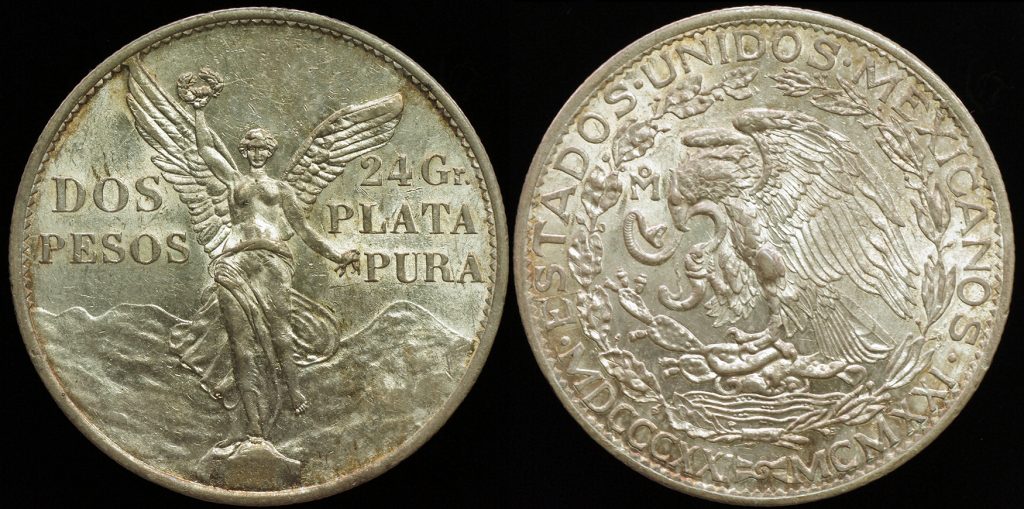United States of Mexico
Centennial of Independence – 2 Pesos 1921
This month we will recognize the 200th Anniversary of our southern neighbor, Mexico. For their 1st Centenary, in 1921, The Bank of Mexico commissioned the Mexico Mint to issue a silver 2 Pesos and a gold 50 Pesos coin. These commemorated the 100th year since Mexico officially became independent of Spain, having declared independence in 1810. Mexico’s National Mint is known as the La Casa de Moneda de Mexico, established in 1535, the Mexican Mint is one of the oldest minting institutions in the Americas.
The obverse design features the Mexican coat of arms, an eagle clutching a rattlesnake while it perches on a prickly pear cactus, all encircled within a wreath. To the side of the eagle’s head is the mint mark “Mo” for the Mexico City Mint. On the outer periphery is the phrase ESTADOS UNIDOS MEXICANO. Beneath the design, in Roman numerals, is the dual date “MDCCCXXI – MCMXXI” (1821 – 1921). While the term ‘Aztec’ is still commonly used, the Mexicans themselves prefer the proper term ‘Mexica’. This group of Native Americans descended from the north, along with other groups, beginning around 1200 CE. They were filling a vacuum left by a previous cultural group known as the Toltecs. Given a sign by one of their main gods, Huitzilopochtli, they were to establish themselves at a place where they saw an eagle clutching the snake. Legend says this occurred on an island in Lake Texcoco where they founded their capital city of Tenochtitlan (1325 – 1345), today’s Mexico City.
The reverse of this coin prominently depicts the Angel of Independence that stands atop a 118-foot tall Corinthian victory column, part of the Monumento a la Independencia, in downtown Mexico City. Built in 1910, the Monument was later converted into a mausoleum where the interred remains of fourteen of the most important heroes of the Mexican War of Independence are now located. Among these are Don Miguel Hidalgo y Costilla or Miguel Hidalgo, the chief instigator and leader for the War of Independence; he’s also known as the “Father of the Nation”. Absent from the mausoleum is Agustín de Iturbide, who achieved Mexico’s independence from Spain in 1821; his remains are in the Metropolitan Cathedral of Mexico City. The 22-foot tall statue is not really of an angel. Enrique Alciati, a French/Italian sculptor, based his sculpture on classical depictions of Nike, the Greek goddess of Victory. Here she holds out an oak victory wreath in one hand and three links of a chain in the other. The theme is a fairly common one. Augustin St. Gaudens, designer of the American $20 gold piece was also inspired by Nike. He too properly included wings in his original design, but in the USA the wings were nixed to better represent Miss Liberty.
The 1921 50 Peso gold coin, sharing the Angel of Independence, was also a centennial commemorative for 1921, with the first year presenting the date range of 1821 – 1921. However, subsequent issues showed the actual strike date even into the period when the coin is considered a bullion issue, up to 1972, but dated 1947. Thus, coins not dated 1921 are not celebrating the ‘Centennial of Independence’. The winged Angel reappeared on 1 Onze gold bullion pieces, and fractionals, beginning in 1981, and on silver Onza in 1982. The Dos Pesos coin featured here is a one-year design for 1921 only. Behind the ‘Angel’ are the volcanoes Popocatépetl and Iztaccihuatl and the coin’s pure silver content at 24 Gr. PLATA PURA. At 39 mm in diameter and composed of .900 silver the coin weighs 26.67 grams. Over 3 million were authorized to be struck but only 1.278 million were. The coin in grade AU and below is fairly common but higher grades of MS 62 to MS 64 become much more valuable. The coin in MS 65 and MS 66 is rare. Rarer still are well-preserved new die state coins that can show feather features on what is normally a highly polished bump that is the eagle’s left knee.
